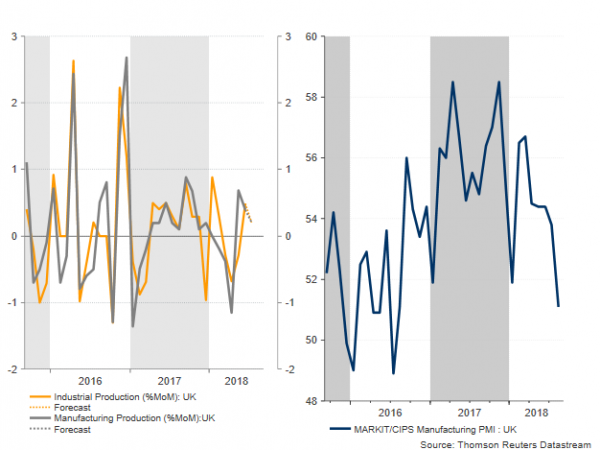Early this week the IHS/Markit Institute indicated that the British manufacturing industry had slowed down to its lowest expansion rate since July 2016 – July 2016 was just after the Brexit referendum – as the country’s export business contracted for the first time in more than two years despite the weakness in the sterling relative exchange rate. The worrisome numbers have now shifted attention to the UK industrial figures due on Monday which could add further fuel to concerns that Brexit and trade uncertainties have already started to put breaks on the UK’s industrial growth. Still, fresh GDP growth readings published on the same day could support that the British economy has overall picked up steam.
At 0830 GMT on Monday, the Office for National Statistics is forecasted to say that on a monthly basis industrial growth has slowed down to 0.4% in July from 0.2% in June, maintaining the yearly gauge steady at 1.1%. Separately in the manufacturing sector, which accounts for about 10% of the British economy, expansion is also expected to ease by 0.2 percentage points to 0.2%, though in yearly terms the sector is projected to lose steam, printing a slightly weaker growth of 1.4% compared to 1.5% in the previous month. While the latter would not create bold headlines, as the change is minimal, investors could take the numbers as an evidence that trade restrictions from the US and the lack of clarity in the Brexit front – particularly whether this would negatively affect UK businesses – have already created hurdles for companies.
The speculation could set off a wave of selling in the pound, which was unable to benefit from good manufacturing export orders in August. Although the currency was depreciating the past five months against the US dollar, foreign demand for UK manufacturing products, fell to the lowest in two years according to the latest PMI survey. Exports of total services and goods for the second quarter showed the strongest deterioration since the end of 2009 as well, plunging by 3.6% y/y. Elsewhere, in the London Exchange Stock Market, the FTSE 100 was another weak spot, as the blue-chip index failed to extend gains on the back of a slipping pound, moving down by 5% after reaching all-time highs in May.
Before taking a position on the pound, however, investors will look at July’s GDP data delivered together with the industrial report as these would give a clue on how the British economy performed at the start of the third quarter. Analysts believe that GDP growth improved to 0.2% m/m from 0.1% in June, driving the yearly measure up by 0.1 percentage points to 1.5%. An equivalent gain is also expected in the three-month growth average which is expected to come in at 0.5%.
Should GDP results appear more encouraging than analysts estimate, proving that the economy in overall had a better start in the third quarter, pound/dollar could surpass today’s high of 1.3028 to touch 1.3058, the 23.6% Fibonacci of the downleg from 1.4376 to 1.2660. Even higher, the focus would shift to the 1.3100 psychological level ahead of the 32.8% Fibonacci of 1.3131. Still, any disappointment in the industrial figures could limit upside movements in sterling.
On the other hand, a worse than expected GDP outcome would cloud views on the economic outlook, sending the pair down to 1.2900 where the price found some support in previous sessions. Stronger bearish corrections could also eye the 1.2800 round level.
Any new Brexit- or trade-related development could override any data impact. Recall that on Friday, transcripts published by the UK parliament showed that the EU Brexit negotiator is open to discussing alternative backstops in the withdrawal agreement. The statement offered a tailwind to the pound, pushing it above 1.30.


 Signal2forex.com - Best Forex robots and signals
Signal2forex.com - Best Forex robots and signals




